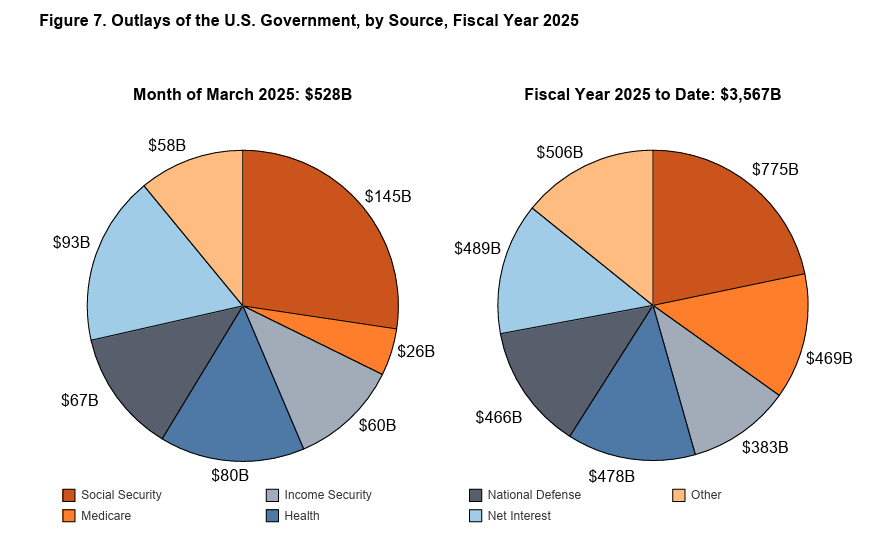(Mike Maharrey, Money Metals News Service) The U.S. government ran the second-largest 6-month budget deficit in history through the first half of fiscal 2025.
The March budget shortfall of $160.53 billion pushed the total deficit through the first half of the fiscal year to $1.31 trillion, according to the latest Treasury Department statement. The only larger six-month budget deficit was $1.7 trillion in the first half of fiscal 2021 when the economy was shut down and the government was spending hand-over-first to cope with the pandemic.
Through the first six months of fiscal 2025, the U.S. Treasury collected $2.26 trillion. That was slightly above the $2.19 trillion collected through the first half of fiscal 2024.
However, according to a Treasury Department official, the 2024 revenue figure was inflated by deferred tax payments from 2023 related to natural disasters.
The real problem is on the spending side of the ledger.
The Trump administration blew through another $528.17 billion last month. That pushed fiscal year-to-date spending to $3.57 trillion. That’s a 9.8 percent increase in spending from the same period in 2024.

Spending was up $139 billion through the first three months of 2025 compared to the same period last year. Borrowing over that period was $41 billion higher.
A Treasury Department official told the Associated Press that the increase in spending was due to a combination of cost of living increases to Social Security, higher Medicaid and Medicare costs, and a jump in Pentagon spending.
You might recall that President Biden promised that the [pretend] spending cuts would save “hundreds of billions” with the debt ceiling deal (aka the [misnamed] Fiscal Responsibility Act).
That never happened.
And appears the Republicans aren’t going to do any better. The spending plan being kicked around by Congress would increase the deficit by some $6 trillion over the next decade.
Committee for a Responsible Federal Budget President Maya MacGuineas called the numbers “undeniable.”
“We are racking up debt at an alarming pace, and it’s unlikely to end any time soon. In fact, lawmakers seem hellbent on adding to that sum with trillions of unpaid-for tax cuts and spending increases. We need to correct the unsustainable course we are on and start focusing on fixing our nation’s finances before it is too late.”
The truth is that the federal government always manages to find new reasons to spend money, whether for natural disasters at home or wars overseas. The Biden administration blew through a staggering $6.75 trillion in fiscal 2024, a 10 percent increase over 2023 outlays.
Interest on the national debt cost $104.4 billion in March. That brought the total interest expense for the fiscal year to $582.46 billion, up 11.6 percent over the same period in 2024.
So far, in fiscal 2025, the federal government has spent more on interest on the debt than it has on national defense ($466 billion) or Medicare ($469billion). The only higher spending category is Social Security.
Uncle Sam paid $1.13 trillion in interest expenses in fiscal 2023. It was the first time interest expense has ever eclipsed $1 trillion. Projections are for interest expense to break that record in fiscal 2025.
Much of the debt currently on the books was financed at very low rates before the Federal Reserve started its hiking cycle. Every month, some of that super-low-yielding paper matures and has to be replaced by bonds yielding much higher rates. And even with the recent Federal Reserve rate cuts, Treasury yields have pushed upward as demand for U.S. debt sags.
This is one of the reasons everybody is clamoring for interest rate cuts.
These big deficits pile onto a national debt that officially topped $36 trillion in November. Currently, the debt level is steady because the federal government is up against the debt ceiling. However, you can expect a huge surge in debt once Congress raises the ceiling. (And it will raise the ceiling.)
Some people claim that borrowing, spending, and big national debts don’t matter.
They do.
According to the national debt clock, the current debt level represents 122.65 percent of the GDP. Studies have shown a debt-to-GDP ratio of over 90 percent retards economic growth by about 30 percent.
And as the Bipartisan Policy Center points out, the growing national debt and the mounting fiscal irresponsibility undermine the dollar.
“Confidence in U.S. creditworthiness may be undermined by a rapidly deteriorating fiscal situation, an increasing concern with federal debt set to grow substantially in the coming years.”
This could lead to lower economic growth, higher unemployment, and less investment wealth.
Lack of confidence in the U.S. fiscal situation could also lower demand for U.S. debt. This would force interest rates on U.S. Treasuries even higher to attract investors, exacerbating the interest payment problem. As already mentioned, we saw a big spike in Treasury yields despite Fed rate cuts.
Biden ran the debt higher at a dizzying pace, but to be fair, this isn’t just a Biden problem. Every president since Calvin Coolidge has left the U.S. with a bigger national debt than when he took office.
It’s going to take more than DOGE rooting out waste to get the borrowing and spending under control. Even if the Trump administration manages to slash discretionary outlays as promised, that only accounts for 27 percent of total spending. The vast majority is for entitlements, and there is little political will to take the scissors to Social Security or Medicare.
And the sad fact is that most people in positions of power are content to kick the debt can down the road. They reason, ‘Nothing has happened yet, so why worry?’ But the problem with playing kick the can down the road is that you eventually run out of road.
Mike Maharrey is a journalist and market analyst for Money Metals with over a decade of experience in precious metals. He holds a BS in accounting from the University of Kentucky and a BA in journalism from the University of South Florida.

